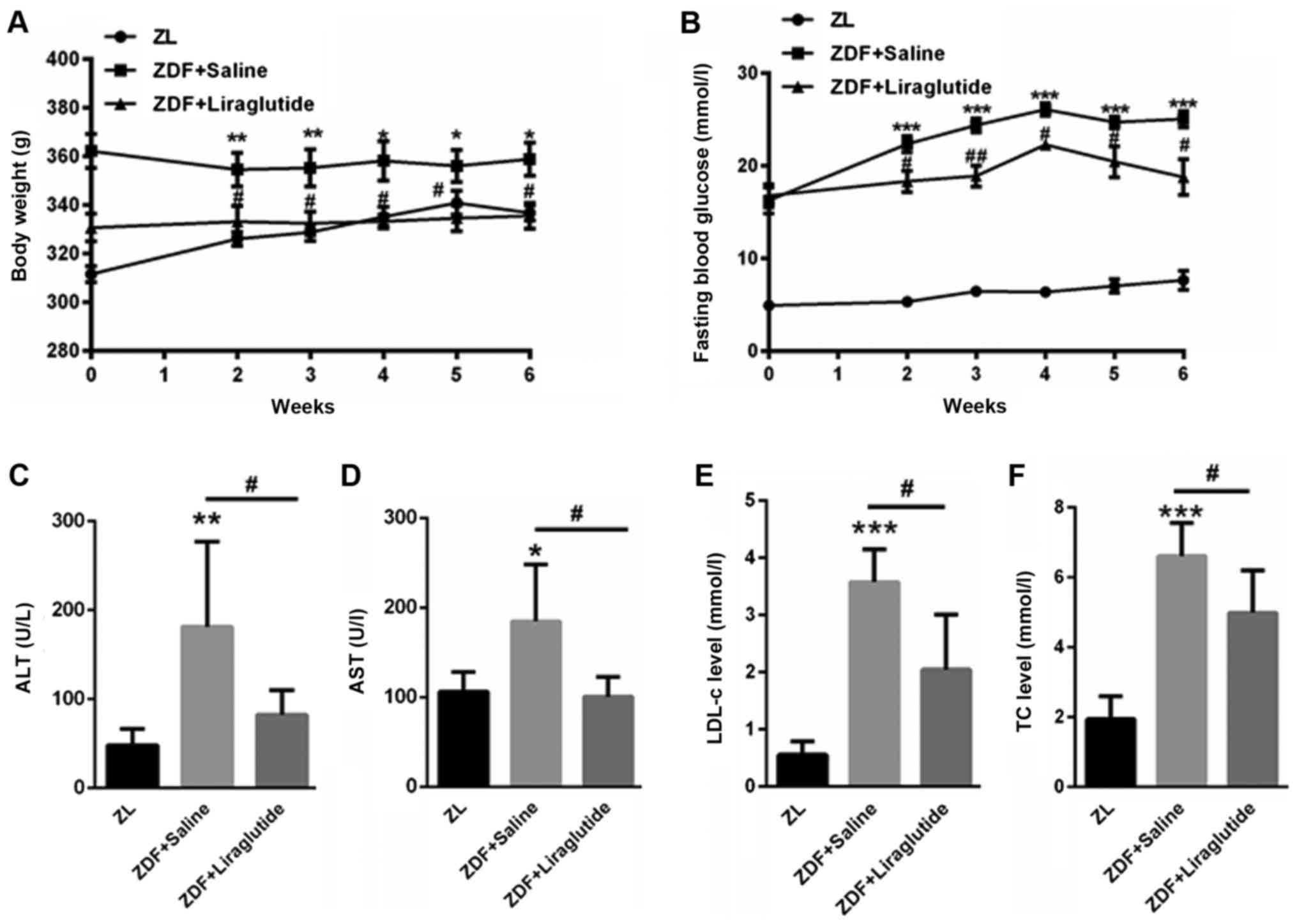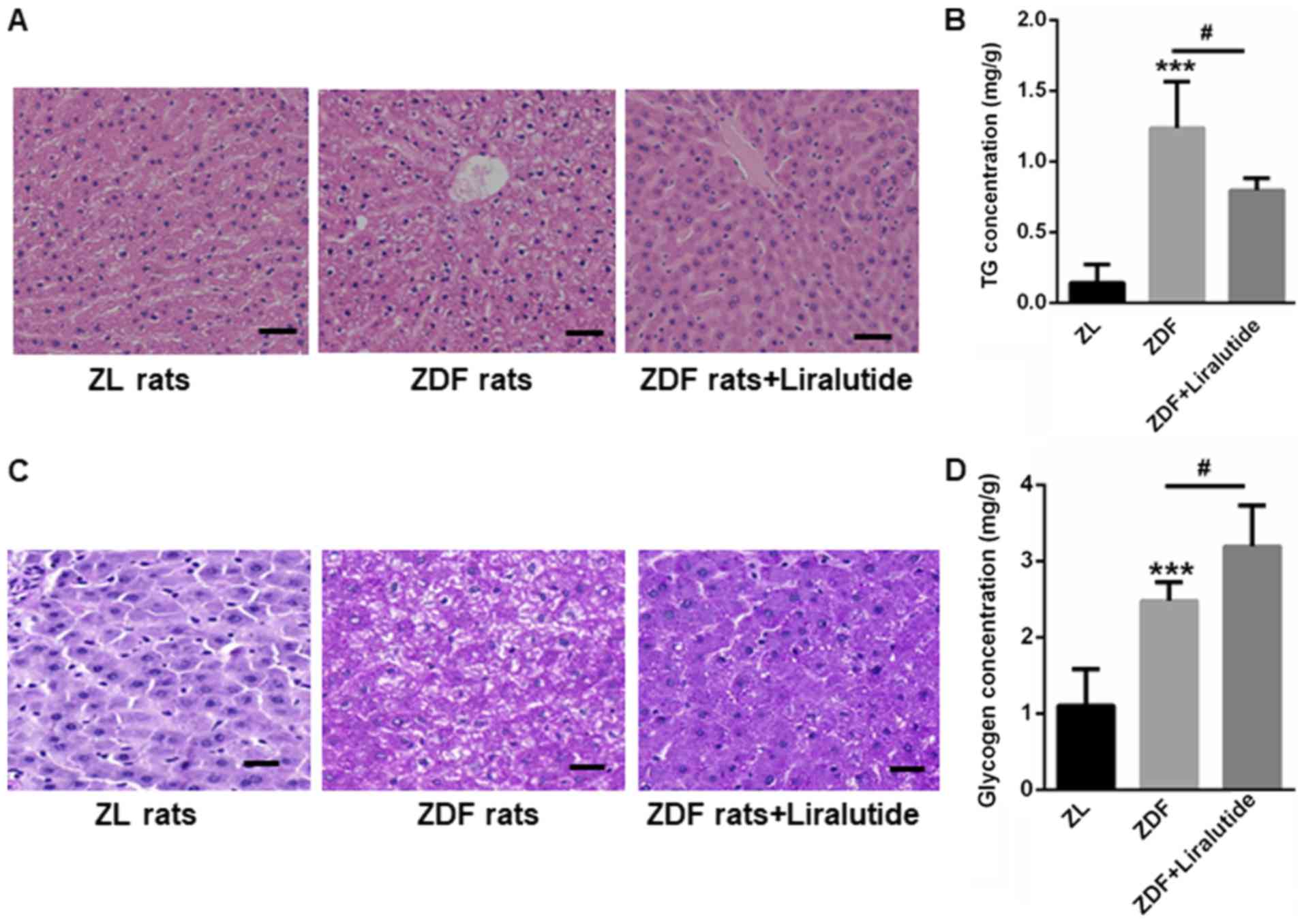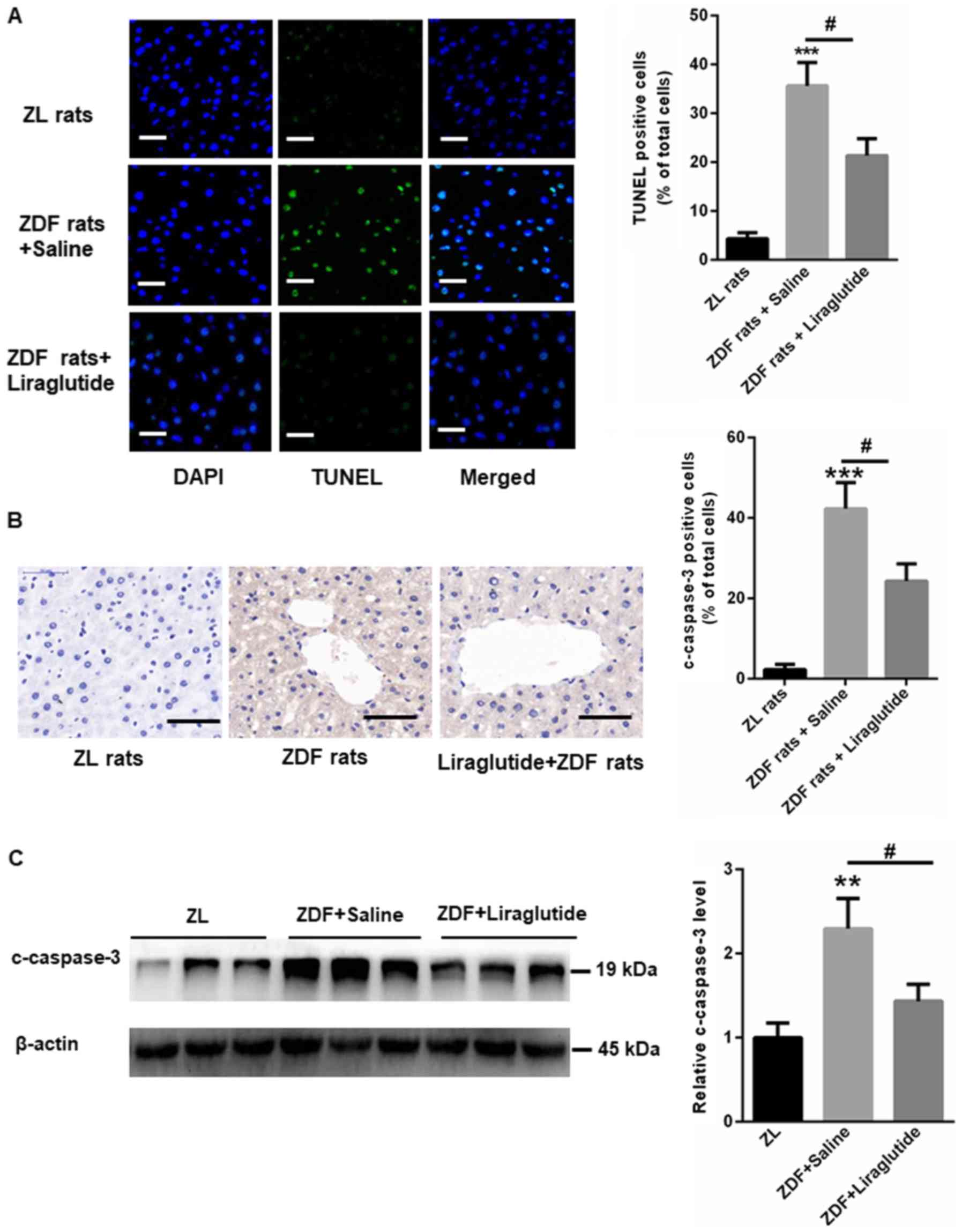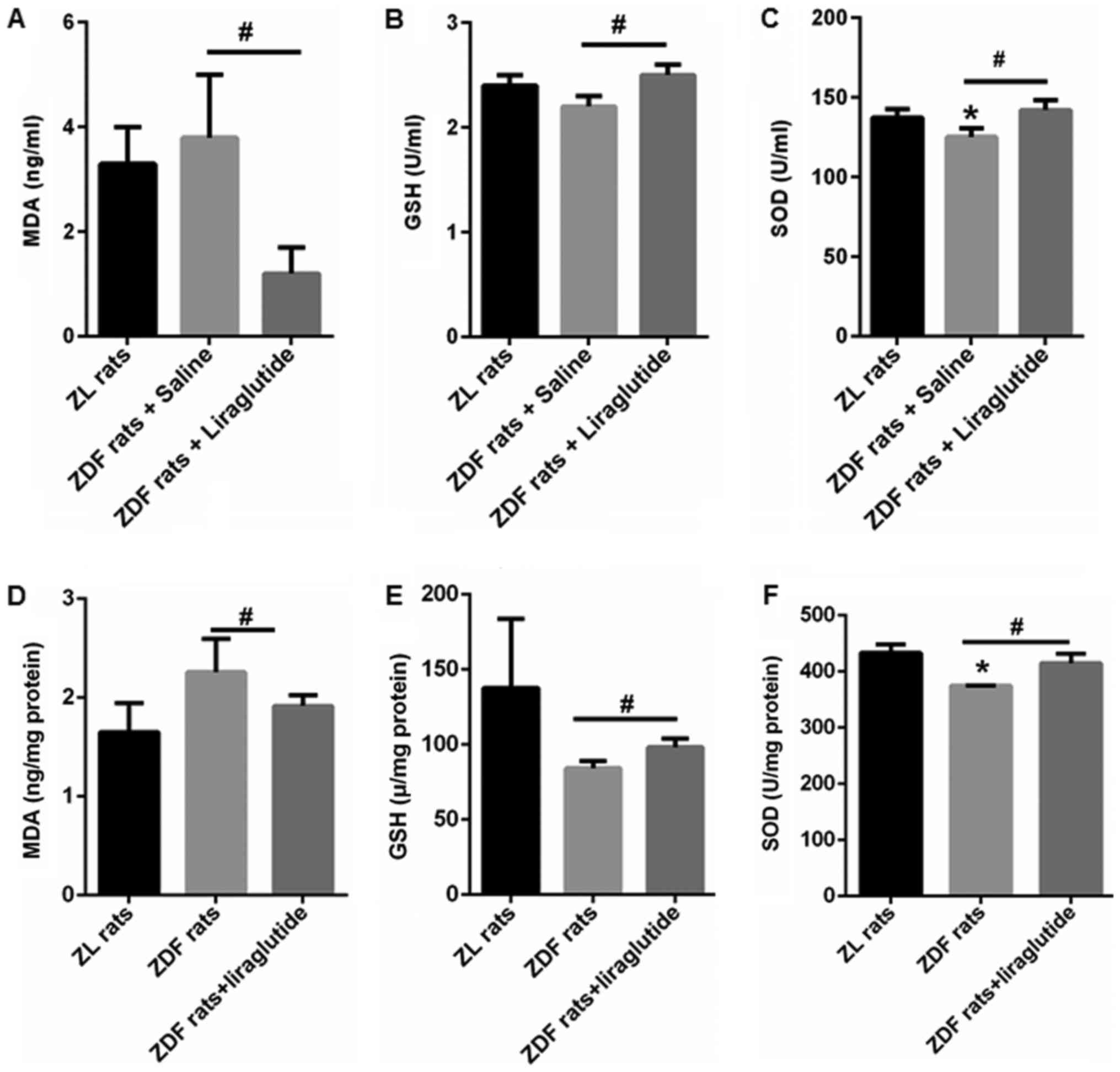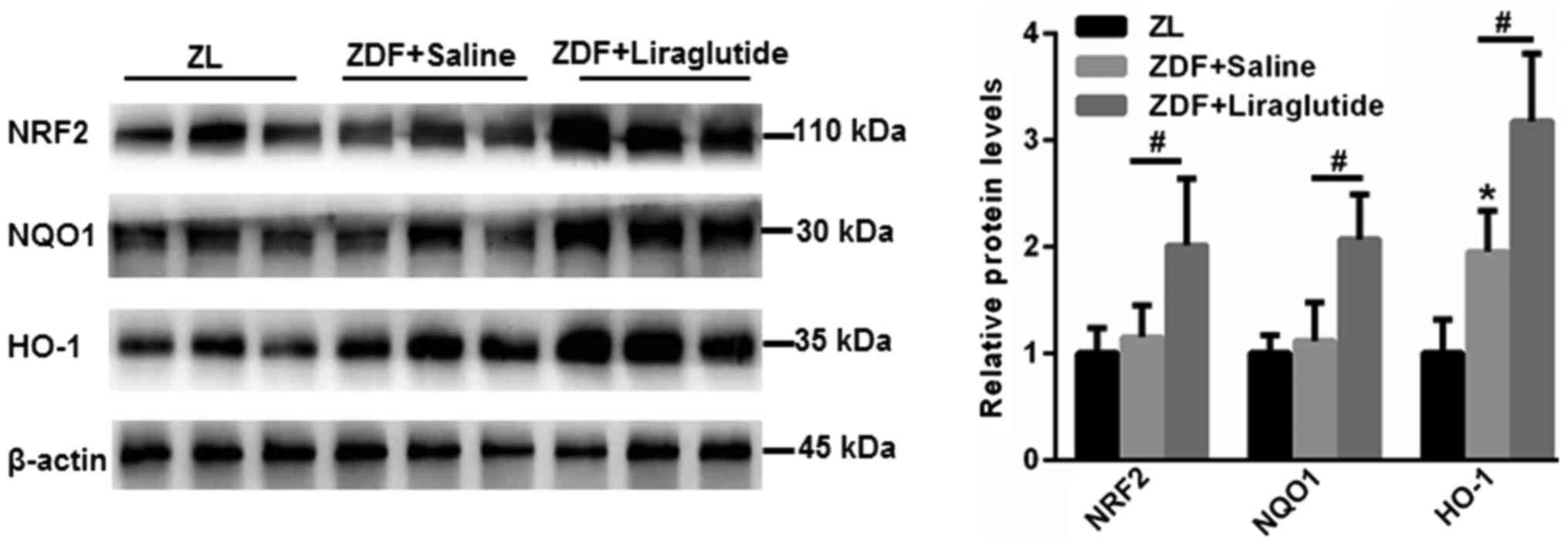|
1
|
Castro AV, Kolka CM, Kim SP and Bergman
RN: Obesity, insulin resistance and comorbidities? Mechanisms of
association. Arq Bras Endocrinol Metabol. 58:600–609. 2014.
View Article : Google Scholar : PubMed/NCBI
|
|
2
|
Li Z, Xue J, Chen P, Chen L, Yan S and Liu
L: Prevalence of nonalcoholic fatty liver disease in mainland of
China: A meta-analysis of published studies. J Gastroenterol
Hepatol. 29:42–51. 2014. View Article : Google Scholar : PubMed/NCBI
|
|
3
|
Xu Y, Wang L, He J, Bi Y, Li M, Wang T,
Wang L, Jiang Y, Dai M, Lu J, et al: Prevalence and control of
diabetes in Chinese adults. JAMA. 310:948–959. 2013. View Article : Google Scholar : PubMed/NCBI
|
|
4
|
Yang W, Lu J, Weng J, Jia W, Ji L, Xiao J,
Shan Z, Liu J, Tian H, Ji Q, et al: Prevalence of diabetes among
men and women in China. N Engl J Med. 362:1090–1101. 2010.
View Article : Google Scholar : PubMed/NCBI
|
|
5
|
Serviddio G, Bellanti F and Vendemiale G:
Free radical biology for medicine: Learning from nonalcoholic fatty
liver disease. Free Radic Biol Med. 65:952–968. 2013. View Article : Google Scholar : PubMed/NCBI
|
|
6
|
Stein Y and Shapiro B: Uptake and
metabolism of triglycerides by the rat liver. J Lipid Res.
1:326–331. 1960.PubMed/NCBI
|
|
7
|
Mota M, Banini BA, Cazanave SC and Sanyal
AJ: Molecular mechanisms of lipotoxicity and glucotoxicity in
nonalcoholic fatty liver disease. Metabolism. 65:1049–1061. 2016.
View Article : Google Scholar : PubMed/NCBI
|
|
8
|
Zámbó V, Simon-Szabó L, Szelényi P,
Kereszturi E, Bánhegyi G and Csala M: Lipotoxicity in the liver.
World J Hepatol. 5:550–557. 2013. View Article : Google Scholar : PubMed/NCBI
|
|
9
|
Hine CM and Mitchell JR: NRF2 and the
phase II response in acute stress resistance induced by dietary
restriction. J Clin Exp Pathol. S4:pii: 7329. 2012. View Article : Google Scholar : PubMed/NCBI
|
|
10
|
Jaiswal AK: Nrf2 signaling in coordinated
activation of antioxidant gene expression. Free Radic Biol Med.
36:1199–1207. 2004. View Article : Google Scholar : PubMed/NCBI
|
|
11
|
Schaedler S, Krause J, Himmelsbach K,
Carvajal-Yepes M, Lieder F, Klingel K, Nassal M, Weiss TS, Werner S
and Hildt E: Hepatitis B virus induces expression of antioxidant
response element-regulated genes by activation of Nrf2. J Biol
Chem. 285:41074–41086. 2010. View Article : Google Scholar : PubMed/NCBI
|
|
12
|
Holland R and Fishbein JC: Chemistry of
the cysteine sensors in Kelch-like ECH-associated protein 1.
Antioxid Redox Signal. 13:1749–1761. 2010. View Article : Google Scholar : PubMed/NCBI
|
|
13
|
Volonte D, Liu Z, Musille PM, Stoppani E,
Wakabayashi N, Di YP, Lisanti MP, Kensler TW and Galbiati F:
Inhibition of nuclear factor-erythroid 2-related factor (Nrf2) by
caveolin-1 promotes stress-induced premature senescence. Mol Biol
Cell. 24:1852–1862. 2013. View Article : Google Scholar : PubMed/NCBI
|
|
14
|
Nauck MA: Incretin-based therapies for
type 2 diabetes mellitus: Properties, functions, and clinical
implications. Am J Med. 124 1 Suppl:S3–S18. 2011. View Article : Google Scholar : PubMed/NCBI
|
|
15
|
Kazafeos K: Incretin effect: GLP-1, GIP,
DPP4. Diabetes Res Clin Pract. 93 Suppl 1:S32–S36. 2011. View Article : Google Scholar : PubMed/NCBI
|
|
16
|
Zueger PM, Schultz NM and Lee TA: Cost
effectiveness of liraglutide in type II diabetes: A systematic
review. Pharmacoeconomics. 32:1079–1091. 2014. View Article : Google Scholar : PubMed/NCBI
|
|
17
|
de Mesquita FC, Guixé-Muntet S,
Fernández-Iglesias A, Maeso-Díaz R, Vila S, Hide D, Ortega-Ribera
M, Rosa JL, García-Pagán JC, Bosch J, et al: Liraglutide improves
liver microvascular dysfunction in cirrhosis: Evidence from
translational studies. Sci Rep. 7:32552017. View Article : Google Scholar : PubMed/NCBI
|
|
18
|
Liang Y, Li Z, Liang S, Li Y, Yang L, Lu
M, Gu HF and Xia N: Hepatic adenylate cyclase 3 is upregulated by
Liraglutide and subsequently plays a protective role in insulin
resistance and obesity. Nutr Diabetes. 6:e1912016. View Article : Google Scholar : PubMed/NCBI
|
|
19
|
Kleiner DE, Brunt EM, Van Natta M, Behling
C, Contos MJ, Cummings OW, Ferrell LD, Liu YC, Torbenson MS,
Unalp-Arida A, et al: Design and validation of a histological
scoring system for nonalcoholic fatty liver disease. Hepatology.
41:1313–1321. 2005. View Article : Google Scholar : PubMed/NCBI
|
|
20
|
Kowluru A and Matti A: Hyperactivation of
protein phosphatase 2A in models of glucolipotoxicity and diabetes:
Potential mechanisms and functional consequences. Biochem
Pharmacol. 84:591–597. 2012. View Article : Google Scholar : PubMed/NCBI
|
|
21
|
Purwana I, Liu JJ, Portha B and Buteau J:
HSF1 acetylation decreases its transcriptional activity and
enhances glucolipotoxicity-induced apoptosis in rat and human beta
cells. Diabetologia. 60:1432–1441. 2017. View Article : Google Scholar : PubMed/NCBI
|
|
22
|
Ford ES, Giles WH and Dietz WH: Prevalence
of the metabolic syndrome among US adults: Findings from the third
National Health and Nutrition Examination Survey. JAMA.
287:356–359. 2002. View Article : Google Scholar : PubMed/NCBI
|
|
23
|
Boudreau DM, Malone DC, Raebel MA, Fishman
PA, Nichols GA, Feldstein AC, Boscoe AN, Ben-Joseph RH, Magid DJ
and Okamoto LJ: Health care utilization and costs by metabolic
syndrome risk factors. Metab Syndr Relat Disord. 7:305–314. 2009.
View Article : Google Scholar : PubMed/NCBI
|
|
24
|
Alberti KG, Zimmet P and Shaw J: Metabolic
syndrome-a new world-wide definition. A consensus statement from
the International diabetes federation. Diabet Med. 23:469–480.
2006. View Article : Google Scholar : PubMed/NCBI
|
|
25
|
Polyzos SA, Kountouras J and Mantzoros CS:
Adipose tissue, obesity and non-alcoholic fatty liver disease.
Minerva Endocrinol. 42:92–108. 2017.PubMed/NCBI
|
|
26
|
Cuthbertson DJ, Irwin A, Gardner CJ,
Daousi C, Purewal T, Furlong N, Goenka N, Thomas EL, Adams VL,
Pushpakom SP, et al: Improved glycaemia correlates with liver fat
reduction in obese, type 2 diabetes, patients given glucagon-like
peptide-1 (GLP-1) receptor agonists. PLoS One. 7:e501172012.
View Article : Google Scholar : PubMed/NCBI
|
|
27
|
Li Q, Lin Y, Wang S, Zhang L and Guo L:
GLP-1 inhibits high-glucose-induced oxidative injury of vascular
endothelial cells. Sci Rep. 7:80082017. View Article : Google Scholar : PubMed/NCBI
|
|
28
|
Brand CL, Galsgaard ED, Tornehave D, Rømer
J, Gotfredsen CF, Wassermann K, Knudsen LB, Vølund A and Sturis J:
Synergistic effect of the human GLP-1 analogue liraglutide and a
dual PPARalpha/gamma agonist on glycaemic control in Zucker
diabetic fatty rats. Diabetes Obes Metab. 11:795–803. 2009.
View Article : Google Scholar : PubMed/NCBI
|
|
29
|
Larsen PJ, Wulff EM, Gotfredsen CF, Brand
CL, Sturis J, Vrang N, Knudsen LB and Lykkegaard K: Combination of
the insulin sensitizer, pioglitazone, and the long-acting GLP-1
human analog, liraglutide, exerts potent synergistic
glucose-lowering efficacy in severely diabetic ZDF rats. Diabetes
Obes Metab. 10:301–311. 2008. View Article : Google Scholar : PubMed/NCBI
|
|
30
|
Zeng J, Deng S, Wang Y, Li P, Tang L and
Pang Y: Specific inhibition of Acyl-CoA oxidase-1 by an acetylenic
acid improves hepatic lipid and reactive oxygen species (ROS)
metabolism in rats fed a high fat diet. J Biol Chem. 292:3800–3809.
2017. View Article : Google Scholar : PubMed/NCBI
|
|
31
|
Levonen AL, Hill BG, Kansanen E, Zhang J
and Darley-Usmar VM: Redox regulation of antioxidants, autophagy,
and the response to stress: Implications for electrophile
therapeutics. Free Radic Biol Med. 71:196–207. 2014. View Article : Google Scholar : PubMed/NCBI
|
|
32
|
Rushmore TH, Morton MR and Pickett CB: The
antioxidant responsive element. Activation by oxidative stress and
identification of the DNA consensus sequence required for
functional activity. J Biol Chem. 266:11632–11639. 1991.PubMed/NCBI
|
|
33
|
Lee JM, Moehlenkamp JD, Hanson JM and
Johnson JA: Nrf2-dependent activation of the antioxidant responsive
element by tert-butylhydroquinone is independent of oxidative
stress in IMR-32 human neuroblastoma cells. Biochem Biophys Res
Commun. 280:286–292. 2001. View Article : Google Scholar : PubMed/NCBI
|
|
34
|
Lee JM, Calkins MJ, Chan K, Kan YW and
Johnson JA: Identification of the NF-E2-related factor-2-dependent
genes conferring protection against oxidative stress in primary
cortical astrocytes using oligonucleotide microarray analysis. J
Biol Chem. 278:12029–12038. 2003. View Article : Google Scholar : PubMed/NCBI
|
|
35
|
Klaassen CD and Reisman SA: Nrf2 the
rescue: Effects of the antioxidative/electrophilic response on the
liver. Toxicol Appl Pharmacol. 244:57–65. 2010. View Article : Google Scholar : PubMed/NCBI
|
|
36
|
Liu J, Wu KC, Lu YF, Ekuase E and Klaassen
CD: Nrf2 protection against liver injury produced by various
hepatotoxicants. Oxid Med Cell Longev. 2013:3058612013. View Article : Google Scholar : PubMed/NCBI
|
|
37
|
Lu H, Cui W and Klaassen CD: Nrf2 protects
against 2,3,7,8-tetrachlorodibenzo-p-dioxin (TCDD)-induced
oxidative injury and steatohepatitis. Toxicol Appl Pharmacol.
256:122–135. 2011. View Article : Google Scholar : PubMed/NCBI
|
|
38
|
Silva-Gomes S, Santos AG, Caldas C, Silva
CM, Neves JV, Lopes J, Carneiro F, Rodrigues PN and Duarte TL:
Transcription factor NRF2 protects mice against dietary
iron-induced liver injury by preventing hepatocytic cell death. J
Hepatol. 60:354–361. 2014. View Article : Google Scholar : PubMed/NCBI
|
|
39
|
Li PC, Liu LF, Jou MJ and Wang HK: The
GLP-1 receptor agonists exendin-4 and liraglutide alleviate
oxidative stress and cognitive and micturition deficits induced by
middle cerebral artery occlusion in diabetic mice. BMC Neurosci.
17:372016. View Article : Google Scholar : PubMed/NCBI
|
|
40
|
Shimoda M, Kanda Y, Hamamoto S, Tawaramoto
K, Hashiramoto M, Matsuki M and Kaku K: The human glucagon-like
peptide-1 analogue liraglutide preserves pancreatic beta cells via
regulation of cell kinetics and suppression of oxidative and
endoplasmic reticulum stress in a mouse model of diabetes.
Diabetologia. 54:1098–1108. 2011. View Article : Google Scholar : PubMed/NCBI
|
|
41
|
He W, Xu Y, Zhang C, Lu J, Li J, Xiang D,
Yang J, Chang M and Liu D: Hepatoprotective effect of calculus
bovis sativus on nonalcoholic fatty liver disease in mice by
inhibiting oxidative stress and apoptosis of hepatocytes. Drug Des
Devel Ther. 11:3449–3460. 2017. View Article : Google Scholar : PubMed/NCBI
|
|
42
|
Lim JS, Mietus-Snyder M, Valente A,
Schwarz JM and Lustig RH: The role of fructose in the pathogenesis
of NAFLD and the metabolic syndrome. Nat Rev Gastroenterol Hepatol.
7:251–264. 2010. View Article : Google Scholar : PubMed/NCBI
|
|
43
|
Musso G, Cassader M and Gambino R:
Non-alcoholic steatohepatitis: Emerging molecular targets and
therapeutic strategies. Nat Rev Drug Discov. 15:249–274. 2016.
View Article : Google Scholar : PubMed/NCBI
|
|
44
|
Ma Z, Li C, Qiao Y, Lu C, Li J, Song W,
Sun J, Zhai X, Niu J, Ren Q and Wen A: Safflower yellow B
suppresses HepG2 cell injury induced by oxidative stress through
the AKT/Nrf2 pathway. Int J Mol Med. 37:603–612. 2016. View Article : Google Scholar : PubMed/NCBI
|
|
45
|
Vani Gokila M, Kumar KJ, Liao JW, Chien
SC, Mau JL, Chiang SS, Lin CC, Kuo YH and Wang SY: Antcin C from
antrodia cinnamomea protects liver cells against free
radical-induced oxidative stress and apoptosis in vitro and in vivo
through Nrf2-dependent mechanism. Evid Based Complement Alternat
Med. 2013:2960822013.PubMed/NCBI
|
|
46
|
Thomas MC: The potential and pitfalls of
GLP-1 receptor agonists for renal protection in type 2 diabetes.
Diabetes Metab. 43 Suppl 1:2S20–2S27. 2017. View Article : Google Scholar : PubMed/NCBI
|
|
47
|
Zhan Y, Sun HL, Chen H, Zhang H, Sun J,
Zhang Z and Cai DH: Glucagon-like peptide-1 (GLP-1) protects
vascular endothelial cells against advanced glycation end products
(AGEs)-induced apoptosis. Med Sci Monit. 18:BR286–BR291. 2012.
View Article : Google Scholar : PubMed/NCBI
|
|
48
|
Schisano B, Harte AL, Lois K, Saravanan P,
Al-Daghri N, Al-Attas O, Knudsen LB, McTernan PG, Ceriello A and
Tripathi G: GLP-1 analogue, Liraglutide protects human umbilical
vein endothelial cells against high glucose induced endoplasmic
reticulum stress. Regul Pept. 174:46–52. 2012. View Article : Google Scholar : PubMed/NCBI
|
|
49
|
Inoue T, Inoguchi T, Sonoda N, Hendarto H,
Makimura H, Sasaki S, Yokomizo H, Fujimura Y, Miura D and
Takayanagi R: GLP-1 analog liraglutide protects against cardiac
steatosis, oxidative stress and apoptosis in streptozotocin-induced
diabetic rats. Atherosclerosis. 240:250–259. 2015. View Article : Google Scholar : PubMed/NCBI
|
|
50
|
Kimura R, Okouchi M, Fujioka H, Ichiyanagi
A, Ryuge F, Mizuno T, Imaeda K, Okayama N, Kamiya Y, Asai K and Joh
T: Glucagon-like peptide-1 (GLP-1) protects against
methylglyoxal-induced PC12 cell apoptosis through the
PI3K/Akt/mTOR/GCLc/redox signaling pathway. Neuroscience.
162:1212–1219. 2009. View Article : Google Scholar : PubMed/NCBI
|



